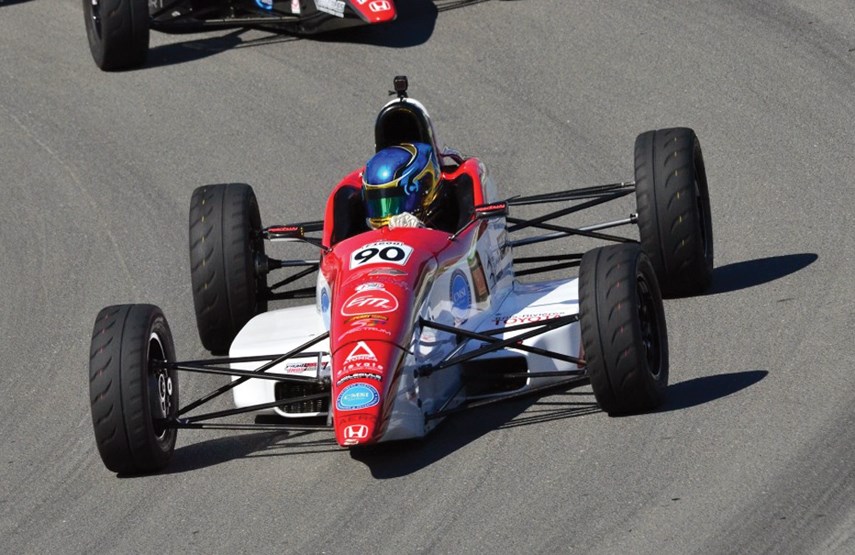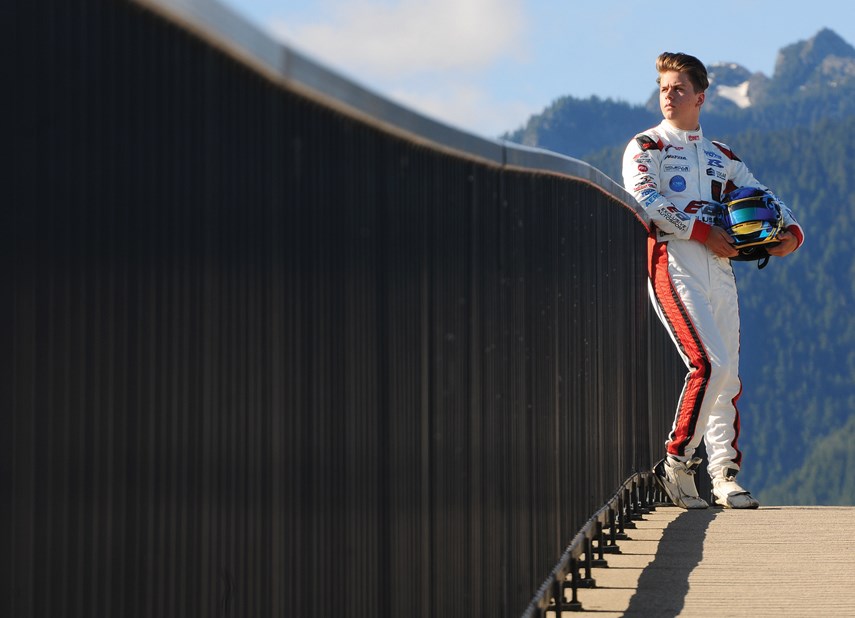With the way that North Vancouver’s Kellen Ritter is racing right now, taking the checkered flag in race after race in cars that can hit up to 230 kilometres per hour, you’d guess that he’s been a daredevil speedster his whole life.
That, however, is not how he remembers it. Instead Ritter recalls jumping into a go-kart for the first time at age five or six and driving terrifyingly, unbelievably … slow.
“It was bad. I was really slow,” the 17-year-old race car driver says with a laugh. “I was actually quite scared of moving faster than walking speed.”
The speed wasn’t there, but that doesn’t mean it wasn’t a thrilling ride.
“When I was done it was so much fun that I wanted to keep doing it,” he says. “It was pushing myself that made it fun.”
That’s how it all started for the up-and-coming racing star who was born in Calgary but moved with his family to North Van when he was around three years old. Ritter’s father wasn’t a racer himself but he loved cars and auto sports, passing that love on to his children by taking them out to race go-karts at a young age. Ritter eventually pushed himself to go faster than a walking pace and then joined a go-kart team based in Chilliwack.
Eventually racing took a backseat to other pursuits when Ritter was in his early teens – “I wanted to be a hockey player … (but) I wasn’t good enough” – but the high speed thrills of the track soon called him back, and Ritter got back into the go-kart game. By the end of Grade 9 at Handsworth Secondary it was becoming unrealistic for Ritter to balance his racing schedule with attending a traditional school, and so he moved to an online-based schooling program and focused even more on finding every last millisecond of speed on a race track. It was around that time that he caught on with a go-kart team based in Langley and his career took off.
“We were able to go out to the track in Chilliwack and just do endless laps until I got tired, and just learn the entire time,” says Ritter. “One of the big things in karts is being able to push the limits. … If you find a limit you push past it, you find a new one until it’s the absolute limit.”
The small wheels and high speeds of high-level go-karting provides an excellent training ground for drivers, Ritter says, adding that it’s hard to keep your hands steady travelling in a little go-kart at 120 km/h.
“It’s quite difficult to drive a go-kart at that high of a speed, but it’s mastering being able to keep it in control but also be pushing it to its absolute limit,” he says. “Finding the fine line is the difficult part.”

All that time in a go-kart obviously prepared Ritter well, because this year he jumped up to real race cars for the first time and has been dominant since nearly Day 1 with the Exclusive Autosport team on the F1600 Canada series. Ritter hit the podium in his second ever race on the circuit, and then had a breakout at the famed Circuit Gilles Villeneuve in Montreal where he won two straight races during F1600 events which coincided with the F1 Canadian Grand Prix. The second win came on Sunday morning in front of thousands of spectators who were arriving for the Formula One race.
“A couple of the grandstands had a couple thousand people in them,” says Ritter. “It’s insane coming by and waving to them and they’re all cheering.”
More big results have followed, including a win and two second-place finishes during a weekend of racing at Canadian Tire Motorsport Park near Toronto June 15-17. With five more weekends of racing on the calendar, Ritter is currently ranked first in all three F1600 series he’s taking part in: Quebec, Ontario and Super Series.
He’ll be back on the track this weekend for the CTCC Summer Challenge at Ontario’s Shannonville Motorsport Park.
The F1600 cars are like bare-bones versions of the F1 cars the superstars of the sport drive.
“If you take away all the incredible technology, it’s basically just a tub with suspension and wheels, which makes it one of the more challenging to drive just because it relies more on the driver than on technology,” says Ritter. “We don’t have paddles like all the new cars, we have a four-speed H-pattern manual box. We have treaded tires so the car doesn’t have that much grip. It’s really tough to drive these things, but once you start perfecting your driving craft it becomes easier and easier.”
It’s also a lot of hot, hard work. The temperature on the track pushed past 40 degrees in Toronto, says Ritter. He’s had to spend a lot of time getting his body physically fit so that he can stay sharp travelling at more than 200 km/h.
“Lots of cardio,” he says. “A lot of people don’t realize how physically straining it is to drive these things. My heart rate throughout the race is a consistent 150. We’re constantly just sweating out everything. … Being able to keep yourself mentally there over 30 minutes in that amount of heat is difficult.”
Many of the drivers on the F1600 circuit are teenagers, but some have been racing for decades. Ritter is hoping he can keep piling up podium finishes and win all three series this season.
Down the road he wants to advance to higher levels in North America or Europe, hoping for a chance to show his driving skill against racers on a level playing field. If he keeps taking checkered flags, maybe someday soon it’ll be him sitting in the fancy F1 car for the main event at Circuit Gilles Villeneuve. Whether or not that moment ever comes, Ritter is enjoying the unique ride he is taking right now.
“It’s a weird sport,” he says with a laugh. “It’s taught me a lot. It’s more of a learning experience everywhere we go. I’m constantly on my own when I’m going to races, minus a few where my parents are there. It’s really good for learning. I learned to be independent. … I’ve learned to enjoy every second of it. It’s one of those things where even if something bad happens, it’s just racing.”
Ritter won’t turn 18 until next February, so he’s not even old enough to hold a full driver’s licence in British Columbia. The humour in that is not lost on the young racer.
“I was driving on the highway yesterday to go see my cousins and we were driving at 100 km/h and it feels slow,” he says. “It really makes me appreciate how fast we go in the (race) car.”
He knows he lives a bit of an odd life. Out on the track, Ritter gets to do things few other drivers in the world get to do, let alone North Vancouver teenagers.
“We’re travelling at 230 kilometres per hour – I just enjoy the rush of driving at these speeds. It’s something else,” he says. “It’s also really cool being the only person I know in this area that races cars.”



